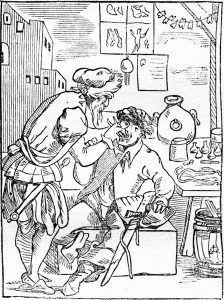
A few decades ago, the vast majority of dental visits were about addressing oral health issues with cleanings and exams. While this will always be a key part of the dental field, in recent years the elective procedures under the cosmetic dentistry umbrella continue to rise in popularity.
Don’t get the impression that cosmetic dentistry just arrived on the scene, however, as it has been around for thousands of years. Keep reading to learn more about some points in history and the progression this branch of dentistry has made.
Etruscans Get the Cosmetic Dentistry Ball Rolling
Turning back the clock, way back to 700 B.C., the Etruscans attempted to replace teeth with a variety of materials. Usually, dentures were constructed from materials like bone and ivory. Occasionally, they utilized teeth from deceased animals or humans.
Ancient Egyptians used seashells to replace their missing teeth. Crowns and bridges could be made using gold. As for teeth whitening, ancient Romans would use urine because the ammonia dissolved stains. Historians believe it was more typically used as a mouthwash and apologies if that tidbit was a TMI situation.
Cosmetic Dentistry in Medieval Times
Dentistry was performed by a barber in the Middle Ages. They would file down teeth and use a special coating to make them whiter. Unfortunately, this would destroy the enamel of the teeth and eventually cause tooth loss. Stick to cutting hair, please.
Europeans rediscovered the lost practices of using bone or ivory as dentures, which wasn’t the most comfortable method as you can imagine. They also brought back using human teeth from dead bodies, but the patient’s body often rejected the new teeth.
Dentistry Enters the Age of Enlightenment
Cosmetic dentistry really took a dramatic turn for the better in the 1700s when porcelain began to be used for dentures. When the 1800s arrived, metals caught on briefly to be placed in the sockets of missing teeth, but the human body rejected them like they did not accept the teeth of the deceased. Porcelain continued to gain in popularity, as dentists began to use molds with plaster to ensure the dentures fit better.
Materials Shift in the 1900s
The materials dentists used in dentures changed almost as soon as the 1900s began. Porcelain dental crowns were not the most economical, so as soon as the dental industry was able to, they switched to plastics and acrylics. Some changes stick, considering that acrylics are still used in modern dentures.
Modern-Day Cosmetic Dentistry Owes the 1980s a Debt of Gratitude
The 1900s saw the focus on creating beautiful, natural-looking teeth rise to new heights. Check out some of today’s popular treatments and their notable dates in the previous century:
- Teeth Whitening: Dentists experimented with the pairing of hydrogen peroxide and a bleaching light in the 1900s, but it didn’t yield results until two dentists started using carbamide peroxide as a whitening agent in 1989. Laser dentistry was invented in the 1960s and was primarily used to treat gum disease until 1996, which the FDA approved a dental laser for whitening.
- Composite Restorations and Bonding: Dental bonding has made a lot of progress over the last century. A white tooth filling material was invented in the 1950s along with an acid etch technique that increased adhesion between fillings and enamel. It wasn’t until the 1980s, however, that more permanent bonding was developed for patients.
- Veneers: They were invented in the 1930s as a temporary fix for film stars, but they were held on by dental adhesive and would fall off after a brief time. Once again, the 1980s were key as a new technique emerged to allow dentists to bond porcelain veneers to teeth.
Cosmetic dentistry has come a long way from using seashells for tooth replacement and urine for teeth whitening. Oops, no one wants that brought back up. Anyhow, there are a variety of options for you to take your smile to new heights. Schedule a consultation with your cosmetic dentist in Arnold to get started!
About the Practice
At JL Dental, you’ll find a private practice with two dentists who are committed to helping every member of your family and staying current on advancements in the dental field along the way. We have a variety of treatments, but a common theme will be a priority on your comfort while you are here. Customer service is particularly important to us, and please don’t hesitate to ever ask any questions to your dentist or by phone before you arrive. Thank goodness for the advancements in cosmetic dentistry, let’s not revisit some of the cringeworthy treatments mentioned in this blog post. If you are interested in upgrading your smile, you can schedule a consultation on our website or by calling (636) 464-6668 to get started.
